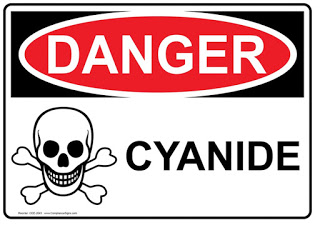 Hydroxocobalamin
Hydroxocobalaminis an antidote that was recently approved by the FDA in 2006 for the treatment
of cyanide poisoning. For decades, cyanide poisoning has historically been
treated using the cyanide antidote kit that contained a concoction of amyl
nitrite, sodium nitrite and sodium thiosulfate. The problem with this antidote
kit is that it can lead to hypotension and reduced oxygen-carrying capacity. In
contrast, hydroxocobalamin does not cause these complications and therefore has
become more widely used for suspected cyanide intoxication.
We
encountered a case of a young man who was found unresponsive and profoundly
hypotensive. On arrival to the emergency room, he was in extremis with
significant agonal breathing. His GCS was 3, he was hypothermic and
hypotensive. He had AKI (creatinine 1.3mg/dl) and a severe anion gap metabolic
acidosis (lactate >20). A bedside echocardiogram showed severely diminished
cardiac function. Blood and urine toxicology screen were negative. Cyanide
poisoning was suspected and as a result, he was given iv hydroxocobalamin.
encountered a case of a young man who was found unresponsive and profoundly
hypotensive. On arrival to the emergency room, he was in extremis with
significant agonal breathing. His GCS was 3, he was hypothermic and
hypotensive. He had AKI (creatinine 1.3mg/dl) and a severe anion gap metabolic
acidosis (lactate >20). A bedside echocardiogram showed severely diminished
cardiac function. Blood and urine toxicology screen were negative. Cyanide
poisoning was suspected and as a result, he was given iv hydroxocobalamin.
Over the
next few hours, he had an increasing pressor requirement and the decision was
made to start dialysis to treat his acidosis and potentially remove any
ingested toxins.
next few hours, he had an increasing pressor requirement and the decision was
made to start dialysis to treat his acidosis and potentially remove any
ingested toxins.
Hemodialysis
was initiated emergently using a Fresenius 2008K machine, however this was
confounded by a recurrent “blood leak alarm” that repeatedly shut down the
machine despite there being no evidence of a leak occurring. After multiple
trials to initiate hemodialysis with replacement of the dialyzer and the
machine, this was aborted with plans to initiate CVVH.
was initiated emergently using a Fresenius 2008K machine, however this was
confounded by a recurrent “blood leak alarm” that repeatedly shut down the
machine despite there being no evidence of a leak occurring. After multiple
trials to initiate hemodialysis with replacement of the dialyzer and the
machine, this was aborted with plans to initiate CVVH.
Hydroxocobalamin
causes an orange/red discoloration of bodily fluids and can permeate dialysate.
This can lead to dialysis failure due to defraction of light from discolored
dialysate, resulting in triggering of the blood leak sensor in certain
hemodialysis machines. The case highlights the need for an awareness of
hydroxocobalamin effects in hemodialysis and its potential to delay initiation
of emergent dialysis in critically-ill patients.
causes an orange/red discoloration of bodily fluids and can permeate dialysate.
This can lead to dialysis failure due to defraction of light from discolored
dialysate, resulting in triggering of the blood leak sensor in certain
hemodialysis machines. The case highlights the need for an awareness of
hydroxocobalamin effects in hemodialysis and its potential to delay initiation
of emergent dialysis in critically-ill patients.
More information on the case can be found here.
Posted by Kenneth Lim



Great Case, Thanks!